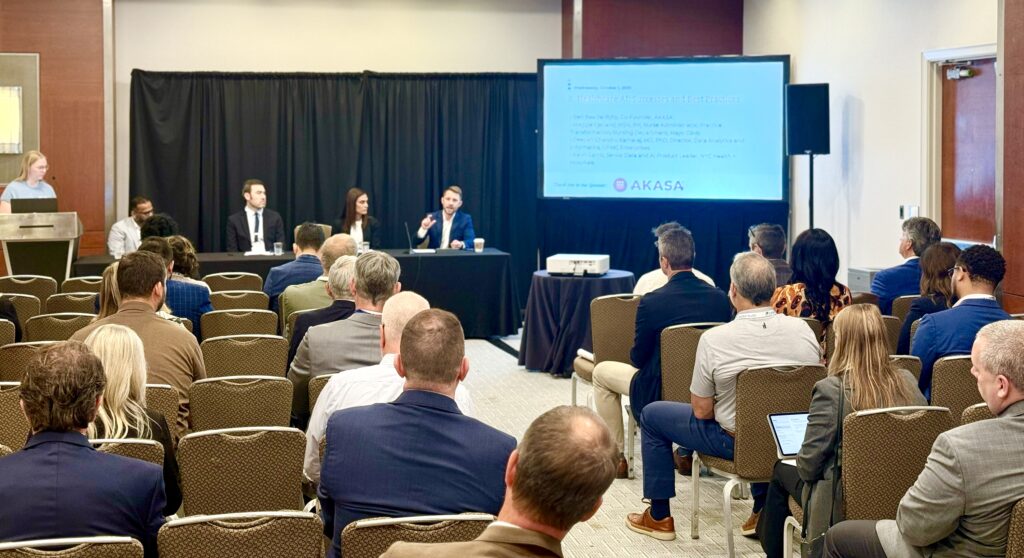The Gist
AI in healthcare is moving beyond hype, and the conversation at Becker’s made that clear. Panelists described how tools are already improving diagnosis in the ED, reducing denials, and even giving nurses back precious minutes with patients. Ben Beadle-Ryby of AKASA underscored the financial side: reviewing 100% of encounters with AI has led to a 6% increase in Present on Admission capture, a 4% increase in comorbidities coded, and $2.8M in additional revenue per 10,000 discharges. Others stressed that equity and accountability must be built in from the start, with frontline staff driving adoption. And while clinical AI grabs the headlines, the panel agreed that operational AI is what “pays the bills” — funding the innovation patients see. Their advice: start small, measure impact, co-create with clinicians, and let mid-cycle wins pave the way for sustainable change.
The Becker’s Health IT + Digital Health + RCM Conference is one of the largest gatherings of healthcare executives, drawing thousands to Chicago each fall. Among the most anticipated conversations this year was the panel “Healthcare AI Successes & Best Practices” on October 1, 2025.
Moderated by Randi Haseman of Becker’s Healthcare, the session featured:
- Ben Beadle-Ryby, SVP and Co-founder of AKASA
- Maggie Fjetland, MSN, RN, Nurse Administrator at Mayo Clinic
- Dr. Deepan Chandru Kamaraj, Director of Data Analytics and Informatics at UPMC Enterprises
- Kevin Lamb, Senior Data and AI Product Leader at NYC Health + Hospitals
Together, the panelists painted a nuanced picture of how AI is being applied across different corners of healthcare — from the emergency department to the nursing station to the back-office revenue cycle. What emerged was less about abstract potential and more about practical realities: where AI is already paying dividends, where accountability and equity must be built in from the start, and what it really takes to turn pilots into lasting change.

Here are the highlights:
Reframing the Documentation Burden
The discussion opened with the role of AI in diagnosis and documentation. Lamb described how NYC Health + Hospitals has deployed AI in emergency departments to suggest likely diagnoses by synthesizing notes, labs, and imaging. The tools don’t replace physicians, but they reduce denials and cut back on wasted hours spent on the phone with insurers. For a public health system serving more than a million patients — half of them uninsured — those efficiencies translate directly into more equitable care.
From the bedside, Fjetland explained how Mayo Clinic is using AI to support nurses. Their virtual nursing assistant sits inside the EHR, curating a patient’s story into a clear summary and surfacing contextual resources. That may sound small, but the impact is profound: fewer minutes hunting through charts means more minutes spent connecting with patients. “Every minute you give a nurse back to direct patient care leads to stronger and safer outcomes,” she said.
Beadle-Ryby shifted the lens to the revenue cycle, where documentation volume is staggering. The average inpatient encounter generates 59 documents and nearly 50,000 words — “the equivalent of reading The Great Gatsby” — and human coders are asked to extract all the relevant details eight to ten times a day. By applying AI to review 100% of encounters before submission, AKASA has uncovered what he called “errors of omission” that even top systems miss.
The results speak for themselves:
- 6% increase in Present on Admission (POA) capture
- 4% increase in Elixhauser comorbidities and HCCs
- Stronger performance on severity, risk, and mortality measures
“We’re not being penalized for poor care,” Beadle-Ryby argued. “We’re being penalized for poor paperwork.”
Equity and Accountability: Designing for Trust
Moderator Haseman steered the conversation toward ethics: how do we build AI responsibly?
Dr. Kamaraj emphasized that bias must be assumed from the start. At UPMC, his team evaluates datasets against the environments where tools will be deployed, then looks for hidden harms in the decision loop. Transparency is non-negotiable.
“We’re not asking the tool just to show the math — we need to see the reasoning,” he said.
Fjetland described how equity is baked into Mayo’s process by engaging nurses across geographies and communities in co-creation. By bringing different perspectives into design and testing, they avoid building tools that only fit a narrow set of patients or providers.
For Beadle-Ryby, accountability manifests differently. Revenue cycle AI, he explained, is bound by compliance guidelines. AKASA starts with a large foundational model trained on millions of clinical and billing documents and then fine-tunes it for each health system. For example, a model trained on Cleveland Clinic’s data looks different than one trained on Stanford’s.
“Each system gets its own model,” he said. “That’s how you respect local nuance and protect record integrity.”
ROI: Where the Rubber Meets the Road
The panel didn’t shy away from the financial realities. “Clinical AI gets the headlines, but operational AI pays the bills,” Beadle-Ryby said, drawing nods across the room.
He backed up the point with data:
- A/R days have grown from 49 in 2019 to 54 today
- Denials are up 27%
- Write-offs have nearly tripled
- Cost to collect has risen from 2.9% to 3.7%
In that context, AI’s impact on the mid-cycle — the quality of documentation and coding — can make or break financial resilience. AKASA benchmarks show $2.8 million in additional revenue for every 10,000 discharges when documentation is accurate from the start.
The other panelists agreed that ROI cannot be measured in dollars alone. Lamb explained how NYC H+H uses revenue cycle savings to reinvest in clinical programs. Fjetland underscored that burnout relief and patient safety should be part of the calculus. Dr. Kamaraj noted that operational efficiency frees up resources to pursue innovation without overburdening clinicians.
Audience members picked up on this thread. One asked bluntly: “What can you definitively point to in terms of ROI?”
Panelists acknowledged the difficulty of quantifying soft outcomes like burnout relief, but Beadle-Ryby highlighted AKASA’s commitment to only getting paid if measurable ROI is achieved. “That’s the new bar healthcare leaders can set for vendors,” he said.
Adoption: Moving From Pilots to Practice
What does it take to move from small pilots to sustainable adoption?
The panelists agreed: Success depends less on the technology itself and more on how it’s introduced.
Lamb encouraged starting with narrow use cases that can show measurable results in weeks, not months. He also stressed the value of finding champions — clinicians or staff who already have credibility and energy for innovation.
Fjetland shared Mayo’s practice of “development units,” safe spaces where nurses can co-create and test tools before a wider rollout. That way, adoption is grounded in trust.
Dr. Kamaraj recommended a precise problem definition: Know exactly who will use the tool, when, and for what decisions, and make that transparent.
Beadle-Ryby emphasized that while revenue cycle AI may be easier to implement because it doesn’t disrupt direct care, adoption still requires quickly demonstrating ROI and communicating the results broadly.
Audience questions pushed the conversation further. Could legacy EHRs keep up?
The consensus: Don’t wait. Pilot outside the EHR, prove value, and then integrate only what’s essential.
Another attendee asked how to build frontline trust. Mayo’s answer: Let staff set the agenda. When they identified documentation burden as the biggest issue, that focus turned skeptics into advocates.
What Healthcare Leaders Should Remember
As the session closed, each panelist reflected on what advice they would give to leaders back home:
- Target the mid-cycle. It’s the most significant lever for both financial and quality outcomes.
- Let operational AI fund clinical AI. Use savings behind the scenes to enable innovation at the bedside.
- Move fast, but start small. Pilot narrowly, measure quickly, and scale what works.
- Engage the frontline. Champions and co-creators build trust and sustain adoption.
- Customize responsibly. Foundation models must reflect each system’s unique patients, payers, and clinicians.
One audience member closed with a practical question: “When you go back to your organizations, what do you hope teams remember?”
The answers were strikingly aligned: Start small, anchor staff in the “why, ” build with, not for, clinicians, and measure what matters most.
Beadle-Ryby tied the discussion to the broader AI moment:
“Since November 2022, when ChatGPT showed us what’s possible, large language models have become part of daily life. Healthcare holds 30% of the world’s data — it’s time to put it to work in ways that are both responsible and ROI-positive.”
As the conversation made clear, healthcare’s AI journey is already well underway — grounded in practical wins, ethical design, and measurable impact.
At AKASA, we’re helping health systems move from pilot projects to proven results, applying generative AI to simplify the revenue cycle and support sustainable, data-driven care. Want to learn more about our technology? Set up a conversation.

Tiffany Smith is the senior director of content and communications at AKASA. A former magazine editor, she has more than 20 years of experience in content, across healthcare, higher education, and finance, among others.








